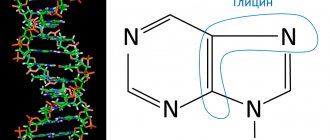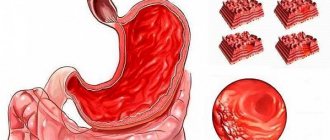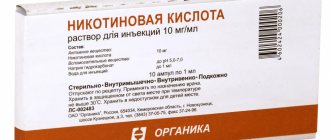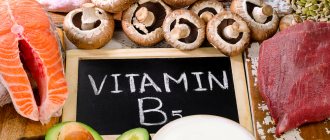Cholinergic synapse[edit | edit code]
Source:
Visual Pharmacology
.
Author
: X. Lulman.
Per. with him. Ed.
: M.: Mir, 2008
Acetylcholine - Vyacheslav Dubynin (Doctor of Biological Sciences, M.V. Lomonosov Moscow State University)
Acetylcholine
(ACh) - a transmitter in postganglionic synapses - accumulates in high concentrations in the vesicles of the axoplasm of the nerve ending. ACh is formed from choline and activated acetic acid (acetyl coenzyme A) under the action of the enzyme acetylcholine transferase. Highly polar choline is actively taken up by the axoplasm. There is a special transport system on the membrane of the cholinergic axon and nerve endings. The mechanism of mediator release has not been fully disclosed. Vesicles are anchored in the cytoskeleton by the synapsin protein in such a way that their concentration near the presynaptic membrane is high, but there is no contact with the membrane. When excitation occurs, the Ca2+ concentration in the axoplasm increases, protein kinases are activated, and phosphorylation of synapsin occurs, leading to the detachment of vesicles and their binding to the presynaptic membrane. The contents of the vesicles are then released into the synaptic cleft. Acetylcholine instantly passes through the synaptic cleft (the ACh molecule is about 0.5 nm long, and the width of the cleft is 30-40 nm). On the postsynaptic membrane, i.e., the membrane of the target organ, ACh interacts with receptors. These receptors are also excited by the alkaloid muscarine and are therefore called muscarinic acetylcholine receptors (M-cholinergic receptors). Nicotine mimics the effect of acetylcholine on receptors at ganglion synapses and the end plate. Nicotine excites cholinergic receptors at ganglion synapses and the end plate of the motor neuron, which is why this type of receptor is called nicotinic acetylcholine receptors (N-cholinergic receptors).
In the synaptic cleft, acetylcholine is quickly inactivated by a specific acetylcholinesterase located in the cleft, as well as by a less specific serum cholinesterase (butyrylcholinesterase) found in the blood serum and interstitial fluid.
Based on their structure, method of signal transmission and affinity for various ligands, M-cholinergic receptors are divided into several types. Let's consider M1, M2 and M3 receptors. M1 receptors are found on nerve cells, such as ganglia, and their activation promotes the transition of excitation from the first to the second neuron. M2 receptors are located in the heart: the opening of potassium channels leads to a slower diastolic depolarization and a decrease in heart rate. M3 receptors play a role in maintaining the tone of smooth muscles, for example, in the intestines and bronchi. Excitation of these receptors leads to activation of phospholipase C, membrane depolarization and increased muscle tone. M3 receptors are also located in gland cells, which are activated by phospholipase C. In the brain there are different types of M-cholinergic receptors that play a role in many functions: transmission of excitation, memory, learning, pain sensitivity, control of brain stem activity. Activation of M3 receptors in the vascular endothelium can lead to the release of nitric oxide NO and thus dilate blood vessels.
Cons of acetylcholine:
— Harmful in stressful situations where you need to act.
- It slows down the body when there is a lot of it. Look at the scientists, 90% are calm and serene like boa constrictors. A dragon will fly by - they will not move. But scientists are smart - and you can’t argue with that.
Correction : people are different and the “sets” of neurotransmitters are different, if a person has a lot of acetylcholine and a lot of glutamate, then he will be faster and more decisive than someone who has the norm. But intellectual potential will change slightly.
Load that increases acetylcholine in natural conditions:
- New information.
— Intellectual or physical training.
Acetylcholine[edit | edit code]
Source:
Clinical Pharmacology by Goodman and Gilman Volume 1
.
Editor
: Professor A.G.
Gilman Ed.
: Practice, 2006.
Acetylcholine
(lat. Acetylcholinum) - a mediator of the nervous system, a biogenic amine related to substances formed in the body.
Acetylcholine plays an important role as a mediator of the central nervous system. It is involved in the transmission of impulses in different parts of the brain, with small concentrations facilitating and large concentrations inhibiting synaptic transmission. Changes in acetylcholine metabolism can lead to impaired brain function.
Acetylcholine is a mediator of nerve impulse transmission to the muscle. With a lack of acetylcholine, the strength of muscle contractions decreases.
The endings of the nerve fibers for which it serves as a mediator are called cholinergic, and the receptors that interact with it are called cholinergic receptors. Cholinergic receptors of postganglionic cholinergic nerves (heart, smooth muscles, glands) are designated as m-cholinergic receptors (muscarine-sensitive), and those located in the area of ganglionic synapses and in somatic neuromuscular synapses are designated as n-cholinergic receptors (nicotine-sensitive). This division is associated with the characteristics of the reactions that occur during the interaction of acetylcholine with these biochemical systems: muscarinic-like in the first case and nicotine-like in the second; m- and n-cholinergic receptors are also located in different parts of the central nervous system.
Storage and release of acetylcholine[edit | edit code]
When microelectrode recording of electrical potentials of the postsynaptic membrane of the neuromuscular synapse, Fatt and Katz (1952) identified spontaneous small (0.1-3 mV) depolarizing potentials that occurred randomly approximately once per second. The authors called these potentials miniature endplate potentials. Their amplitude was significantly below the threshold for the development of an action potential. They increased under the influence of the AChE inhibitor neostigmine and were blocked by tubocurarine (a competitive blocker of N-cholinergic receptors); therefore, they were due to the release of acetylcholine. In this regard, it was suggested that acetylcholine is released from presynaptic endings in fractional constant portions - quanta. The morphological substrate of quanta, synaptic vesicles, was soon discovered (De Robertis and Bennett, 1955). When an action potential arrives at the axon terminal of a motor neuron, 100 or more quanta (vesicles) of acetylcholine are released (Katz and Miledi, 1965). The patterns of acetylcholine storage and release studied at the neuromuscular junction are also applicable to other cholinergic synapses with fast transmission.
It is estimated that each vesicle contains from 1000 to 50,000 molecules of acetylcholine, and the presynaptic terminal of a motor neuron contains 300,000 or more vesicles. In addition, it is possible that a fairly significant amount of acetylcholine is diffusely dissolved in the axoplasm. Recording of currents of single channels of the postsynaptic membrane of the neuromuscular synapse with constant application of acetylcholine showed that one molecule of this mediator causes a potential of the order of 3 x 10”7 V. It follows from this that even the minimum (according to calculations) amount of acetylcholine in one vesicle is 1000 molecules — is sufficient to induce a miniature endplate potential (Katz and Miledi, 1972).
Exocytosis of acetylcholine and other mediators from presynaptic terminals is suppressed by botulinum toxin and tetanus toxin - poisons of Clostridium botulinum and Clostridium tetani, respectively. These anaerobic spore-forming organisms produce some of the most potent toxins known (Shapiro et al., 1998). Clostridium toxins, consisting of heavy and light chains linked by disulfide bridges, bind to an as yet unknown receptor at the cholinergic terminal and are then transported through endocytosis into the cytosol. The light chain is a zinc-containing endopeptidase that, upon activation, hydrolyzes core components of the SNARE complex involved in exocytosis. Different types of botulinum toxin destroy different proteins of the presynaptic membrane (syntaxin-1 and SNAP-25) and synaptic vesicles (synaptobrevin). Botulinum toxin A as a drug is discussed in Chapter. 9 and 66.
Tetanus toxin is a poison of central action: it is retrogradely transported along the axons of motor neurons into the bodies of these neurons in the spinal cord, then passes into the inhibitory neurons associated with motor neurons and blocks the exocytosis of the transmitter from the latter. This is what leads to the cramps characteristic of tetanus. The venom of the black widow spider, α-latrotoxin, binds to transmembrane proteins of presynaptic terminals called neurexins, causing massive exocytosis of synaptic vesicles (Schiavo et al., 2000).
Adenosine
All chemical reactions in the body require energy. The currency used in this process is an adenine molecule with several phosphoric acid bases. Immediately after your “salary” you will see “three hundred rubles” on your card - a molecule of adenosine triphosphate
with three phosphoric acid residues.
Each transaction costs one hundred rubles, respectively, after the first “purchase” there will be only two hundred rubles left on the account (adenosine diphosphate
), after the second - one hundred rubles (adenosine
monophosphate
), after the third - zero rubles.
A bill of zero rubles is adenosine. As a neurotransmitter, it is responsible for feeling tired and falling asleep. During sleep, threes are added to bills of zero-zero rubles, adenosine is transformed into adenosine triphosphate, and we are ready to return to work with renewed vigor.
There is a way to deceive the “banking system”: block adenosine receptors and go on credit. This is exactly what caffeine does - it allows you to ignore fatigue and continue working. At the same time, it does not bring real energy, but only allows you to spend money, as if you still have three hundred rubles. Like any loan, you have to pay for overspending - with greater fatigue, retardation of attention, and addiction. However, caffeinated coffee, tea and chocolate are the most popular stimulants in the world.
There are four known types of adenosine receptors, which are activated and blocked by adenosine. The ADORA2A gene encodes type 2 adenosine receptors, which are involved in the activation of anti-inflammatory processes, the formation of the immune response, the regulation of pain and sleep. The speed of the body’s response to injury and injury depends on the functioning of this receptor.
Read also[edit | edit code]
- Anatomy and physiology of the nervous system
- Parasympathetic nervous system
- Sympathetic nervous system
- Synaptic transmission
- Cholinergic receptors and synapses
- Cholinomimetics
- Anticholinergics
- Nicotine
- M-cholinergic receptor stimulants
- M-cholinergic receptor blockers
- Acetylcholinesterase inhibitors (AChE)
- Poisoning with acetylcholinesterase blockers
- Nerve transmission at neuromuscular synapses and autonomic ganglia N-cholinergic receptors
- Muscle relaxants
- Agents acting on the autonomic ganglia
- Ganglion stimulators
- Ganglioblockers
Pros of acetylcholine:
— Improves the cognitive abilities of the brain, makes you smarter.
— Improves memory, helps in old age.
— Improves neuromuscular connection. Useful in sports, due to faster adaptation of the body to stress. It will indirectly force you to lift more weight or run a distance faster, through rapid adaptation to existing conditions.
— Acetylcholine is not stimulated by any drugs, but rather is suppressed, there is no reason for abuse. Acetylcholine is most suppressed by hallucinogens. This is logical; for delirium to occur, you need a dull brain.
- Overall, a useful neurotransmitter for everyday calm life. Helps you plan, reduce impulsive decisions and mistakes. Corresponds to the proverb “Measure twice, cut once.”


![Table 1. Comparative characteristics of the mechanisms of action of GABA, benzodiazepines and ROS [15–18]](https://laram-halal.ru/wp-content/uploads/tablica-1-sravnitelnaya-harakteristika-mehanizmov-dejstviya-gamk-benzodiazepinov-i-afk-330x140.jpg)





